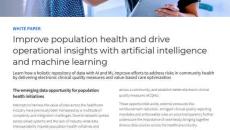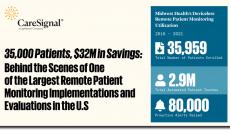Population Health
Data interoperability supports population health and enhanced care delivery for healthcare organizations (HCOs). However, interoperability can also foster data exchange in use cases outside the health system’s facilities.
External pressures like reimbursement reduction, clinical quality reporting mandates and price transparency rules further underscore the importance of bringing together diverse data sources.
The U.S. healthcare sector is facing unprecedented challenges, including an aging population, growing consumerism, changes in regulation and more. All these challenges put pressure on finances and staff as health systems struggle to cope with additional workloads. However, these challenges also present opportunities to build on the introduction of...
Many healthcare providers enter important patient information using free-form text in the “notes” section of the EHR. This can result in clinical information that is unstandardized or uncategorized – meaning that important patient details may get lost. Natural language processing (NLP) solutions scan unstructured text to extract...
Social determinants of health (SDOH), or economic and social conditions that contribute to differences in health equity such as education access and quality, economic stability and healthcare access, contribute to differences in health equity across populations. While the clinical environment may not be sufficient to address all non-clinical...
In a recent HIMSS survey, 59% of hospital leadership staff said that they have lost potential reimbursements over the last year due to poor data quality, and 47% reported inaccuracies in their quality reporting due to poor-quality data.
Discover how a leading health system transformed their care management strategy with Deviceless Remote Patient Monitoring, centralized 24/7 care management teams, and streamlined workflows to reach more patients, faster, and with less resources. Over 35,000 patients participated and claims analyses showed a total medical cost reduction of over $30...
Sponsored
Pediatric health providers—including health systems, pediatric care organizations, and clinically integrated networks—are under increasing financial pressure as a result of the COVID-19 pandemic, a declining birth rate, and increased awareness of health inequities. When you consider the current shift toward value-based care models in...
Healthcare-associated infections (HAIs) affect over 1.7 million people per year in the United States. During the pandemic, healthcare facilities have developed new safety and sanitization protocols to protect patients and staff. Using antimicrobial solutions can fight germs at their source and reduce the rate of HAIs.
COVID-19 transformed how we collectively delivered care in 2020. Not only are we seeing an upending of traditional health care settings, but patients increasingly expect to know the costs of their care ahead of time. In fact, many wonder how COVID-19 has permanently changed the way patients receive care and interact with the healthcare system. In...



























